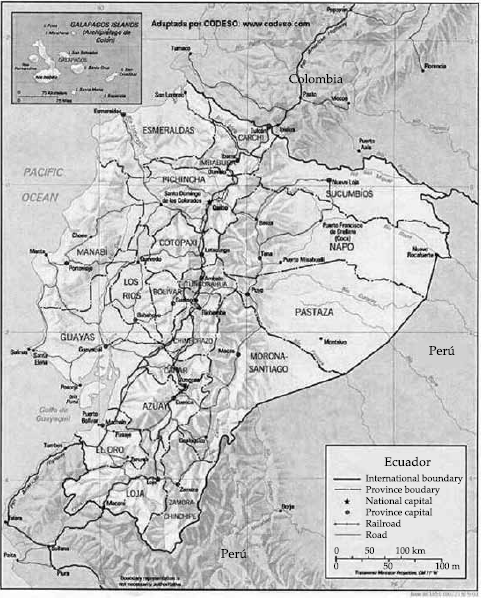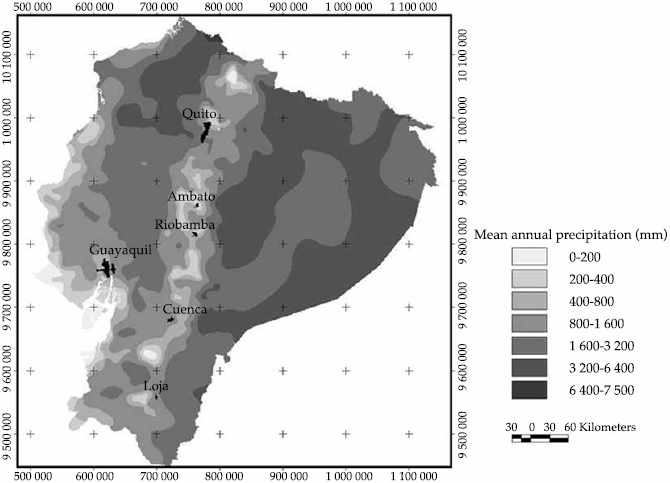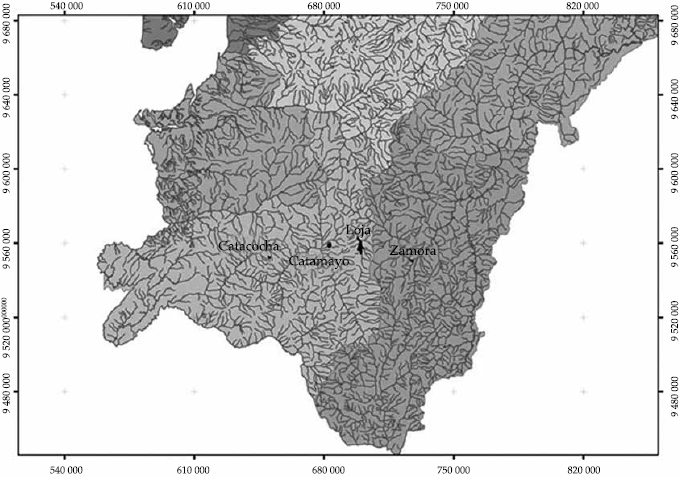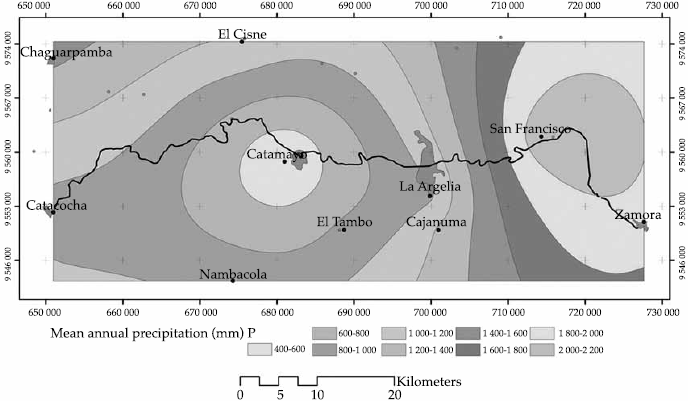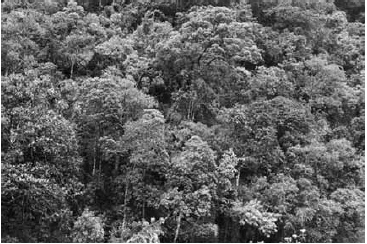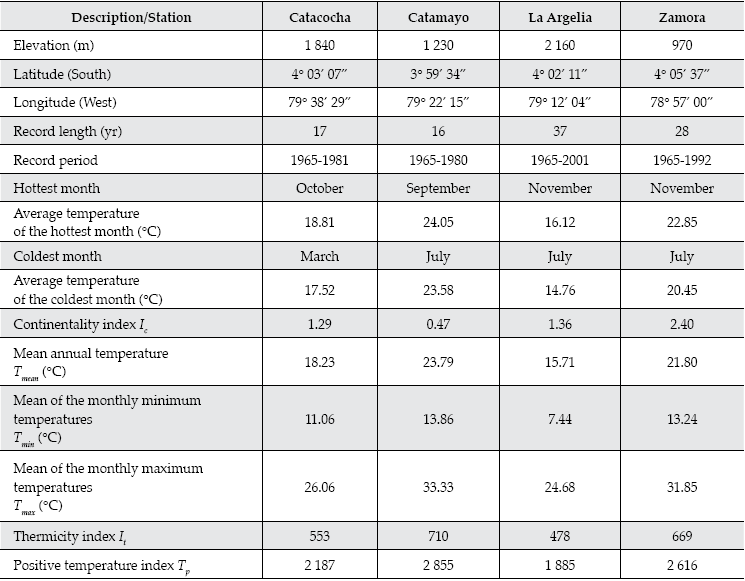Introduction
Ecuador is endowed by Nature with unmatched ecological diversity. This is due to: (1) its geographical location along the Equator, (2) its relative continental position next to the Pacific Ocean, and (3) the presence of the Andes Mountain Range, which crosses the middle of the country from North to South (Figure 1). This unusual combination of near-zero latitude, proximity to a very large moisture source, and wide altitudinal range is responsible for a substantial ecological and biological diversity. Therefore, the region constitutes a veritable field laboratory for the study of tropical ecological, hydrological, and climatological relations.
The general objectives include describing the uniqueness of the chosen study region and its climatological and geomorphological characteristics, with aim to establish the appropriate foundations for the nascent field of ecohydroclimatology, interpreted as the seamless approach to ecology, hydrology, and climatology. Specific objectives include the description of mean annual precipitation, terrain geology and geomorphology, relation of flora to distance to groundwater, and appropriate climatic indicators such as the various bioclimatological indexes.
This study focuses on the southern provinces of Loja and Zamora-Chinchipe (Figure 1). These regions feature marked gradients in mean annual precipitation within a relatively short distance. Figure 2 shows mean annual precipitation in Loja and Zamora-Chinchipe, varying between 200-400 mm in Loja to 32006400 mm in Zamora-Chinchipe. Thus, a transect of relatively limited length transversing these two provinces is appropriate for the study of ecohydroclimatological relations.
This study is part of a research program in ecohydroclimatology carried out jointly by San Diego State University (San Diego, California, USA) and the Universidad Tecnica Particular de Loja (Loja, Ecuador).
Geographical Setting
The provinces of Loja and Zamora are located in southern Ecuador. Wolf (1892) has described the geology, geomorphology, and hydrography of Ecuador, including Loja and Zamora. The Andes Mountain Range transverses the study region, from the Sabanilla Knot, to the south of Loja, to the moorlands of Saraguro, toward the north.
From the Sabanilla Knot, the Santa Rosa Range takes off to the northwest and the Condor Range to the southeast. The Santa Rosa Range is narrow, low, and relatively small. From the Condor Range, several large branches take off toward the northeast.
From 4° 8' S latitude, south of the city of Loja, the Western Range runs parallel to the Eastern Range in a general northern direction. The Western Range is narrow, with short branches on both sides, rising up to 3000 m through most of its length. In contrast, the Eastern Range rises up to 4000 m. These two branches of the Andes are united by two transversal knots, the Cajanuma Knot to the south of Loja, and the Guagrauma Knot to the north. The region comprised between the knots constitutes the valley of Loja.
The valley of Loja, oriented from north to south, is divided into two different sections. The northern section is narrow, resembling a canyon. The southern section, properly the valley of Loja, is oval-shaped, with a total length comprising about 6 km and a maximum width of about 3 km.
The Malacatos River has its headwaters in the Cajanuma Knot, flowing north to meet the Zamora river at Loja proper, where it takes the name of the latter. Continuing to flow north through the Guagrauma Knot, the Zamora river meets several tributaries along its course, eventually discharging into the Santiago river in the eastern lowlands of Zamora-Chinchipe province.
The interandean valley of Loja is small and low, at 2150 m altitud, with the city of Loja occupying the entire valley. The lowest point on the road (pass) from Loja through Cajanuma Knot to the south is at 2525 m altitude. The lowest point on the road from Loja to Catamayo to the west is at 2786 m. This pass is next to Villonaco peak, which rises to about 3000 (Wolf, 1892).
Conceptual Framework
This study sets the foundations to describe the characteristics of vegetative communities, using the interdisciplinary perspective of ecohydroclimatology. Several factors condition the type and density of vegetative communities across the landscape. The most important are:
Mean Annual Precipitation
Mean annual precipitation determines the humidity provinces (arid, semiarid, subhumid, or humid) (Holdridge, 1947). Plants respond readily to the presence of environmental moisture, including that in the air, land surface, vadose zone (unsaturated soil), and that flowing underground. Low relative humidity in the air is usually associated with low moisture levels on land surface and soil, together with the presence of ephemeral streams and relatively deep groundwater. Conversely, high relative humidity is usually associated with high moisture levels on the land surface and soil, coupled with perennial streams and shallow groundwater. In practice, these elements of the landscape are all related, with a common denominator: high environmental moisture means humid, while low moisture means arid.
Terrain Geology and Geomorphology
Next to climate type, terrain geology and geomorphology are generally a good indicator of vegetation type (Cole, 1960; Ponce & Da Cunha, 1993). Notwithstanding other factors, terrain geology and geomorphology determine the relation between surface water and groundwater. Plants may transpire either vadose water, groundwater, or both (Ponce, 2006). Land surface slope and rock/soil type determine the quantity of surface flow, surface detention and retention, infiltration rate, depth to water table, and groundwater replenishment. In addition, drainage conditions, either exorheic, endorheic, or mixed exorheic-endorheic, by interacting with soil and groundwater salinity, determine the type and density of vegetative communities that prevail across the landscape.
Proximity to Groundwater
Vegetative communities referred to as phreatophytes specialize in satisfying their water needs directly from the underlying groundwater. In essence, shallow groundwater supports the growth of plants that habitually feed on groundwater (Meinzer, 1927). Thus, the presence of phreatophytes is a good indicator of shallow groundwater in the vicinity.
Speed of Surface Drainage
Land slopes vary widely, from larger than 30% in certain mountainous landscapes (Ponce,2008), to near zero in some geologically controlled depositional landscapes or broad river valleys undergoing geologic subsidence (Ponce, 1995). Very mild terrain slopes lead to swamps and wetlands and their characteristic vegetative community structures, including the dynamics imposed by seasonal variations, floods and droughts, and more recently, anthropogenic climate change.
Seasonal Variations in Temperature
Plants are naturally adapted to seasonal variations in temperature, which are conditioned by latitude, altitude, and continental location relative to the nearest moisture source. Desert plants readily adapt to wide variations in seasonal temperature, while rainforest plants do not.
Annual Precipitation
The transect chosen for this study comprises the section between Catacocha, in central Loja province, to Zamora, in western Zamora-Chinchipe (Figure 3).
Figure 4 shows a map of mean annual precipitation for the study transect. Data from ten (10) climatological stations were used to develop this map. The stations are, from west to east: (1) Chaguarpamba, (2) Catacocha, (3) Nambacola, (4) El Cisne, (5) Catamayo, (6) El Tambo, (7) La Argelia (in Loja), (8) Cajanuma, (9) San Francisco, and (10) Zamora. The locations of the stations are shown in Figure 4.
Mean annual precipitation varies from 400 mm in Catamayo to 2200 mm in San Francisco, depicting a marked precipitation gradient. The straight distance between Catamayo and San Francisco is about 40 km, while the straight distance between Catacocha and Zamora is about 80 km. Significantly, the city of Loja, capital of the province of Loja, is located at midrange along the Catamayo-San Francisco subtransect.
Figure 5 shows an image of the Catacocha-Zamora transect, revealing the marked diferences in vegetation along the transect. Albedo, a reliable indicator of the presence or absence of vegetation is estimated to vary between as high as 0.30 near Catamayo, to as low as 0.05 near San Francisco (Ponce, Lohani, & Huston, 1997). Figure 6 shows a longitudinal profile of the Catacocha-Zamora transect, corresponding to Figure 5. The Catacocha, Catamayo, Loja, and Zamora valleys are indicated in the profile.
Figure 7 shows an image of the Catamayo-Zamora transect, at somewhat larger scale that the previous image, again revealing the marked diferences in vegetation type and density along the transect. Pulgar, Izco and Jadan (2010) have noted that mean annual precipitation at an isolated spot at Cerro El Consuelo, near San Francisco, has been measured at 6 259 mm. Also, they have documented the number of rainy months to vary from 1-2 for Catamayo (a hyperarid climate) to 11-12 for San Francisco (a hyperhumid climate) (Ponce, Pandey, & Ercan, 2000). Thus, the Catamayo-San Francisco subtransect appears to be optimal for the study of tropical ecohydroclimatological relations.
Figure 7 shows an image focused on the Loja valley, showing the marked differences in vegetation density from the mountains west of Loja to those east of Loja, a distance of less than 20 km. Mean annual precipitation (Figure 8) varies from 800-1000 mm to the west and 1600-1800 mm to the east.
Vegetative Landscapes
Figures 8 and 9 show the contrast between typical landscapes and associated vegetative communities in Catamayo and Zamora, respectively. Figure 8 shows a hilly landscape covered with short semiarid shrubs and grasses, while Figure 9 shows a dense tropical montane humid forest, featuring relatively tall trees. Ongoing field research is aimed at identifying the spatial distribution, density, size, and other relevant characteristics of vegetative species and communities along the study transect.
Bioclimatological Indexes
Three indexes are used to study bioclimatological relations (Rivas-Martínez 2007):
Continentality index
This index is equal to the average temperature of the hottest month Thot minus the average temperature of the coldest month Tcold .
The following procedure is used to calculate Thot :
The maximum daily temperature, for each month and year of record is identified, and the mean maximum monthly temperature is calculated.
The mean of the mean maximum monthly temperature is calculated for the entire record.
The month with the highest mean of the mean maximum monthly temperature is selected as the hottest month.
A similar procedure is applied to calculate Tcold .
The continentality index varies between Ic = 0 for an extreme oceanic influence, to Ic = 65 for an extreme continental influence.
Thermicity index
This index is equal to the mean annual temperature Tmean plus the mean of the monthly mean minimum temperatures Tmin plus the mean of the monthly maximum temperatures Tmax . The sum is multiplied by 10.
The mean annual temperature is the mean of the (12) mean monthly average temperatures. The mean of the monthly minimum temperatures in the mean of the (12) mean monthly minimum temperatures. The mean of the monthly maximum temperatures in the mean of the (12) mean monthly maximum temperatures.
Positive Temperature Index
This index is equal to the sum of all positive (nonnegative) mean monthly temperatures. The sum is multiplied by 10.
Table 1 shows the classification of climates as a function of the continentality index. Table 2 shows the classification of climates as a function of the thermicity and positive temperature indexes. Table 3 shows the indexes calculated for the following stations: (1) Catacocha, (2) Catamayo, (3) La Argelia, and (4) Zamora. Table 4 shows the climatic classification for the stations considered in this study.
The low continentality index of the stations along the study transect justifies its classification ashyperoceanic (Table 1). This is attributed primarily to its geographical location near the Equator, and secondarily to its near proximity to the Pacific Ocean.
Summary
Ongoing ecohydroclimatological research along the Catacocha-Zamora transect in the provinces of Loja and Zamora-Chinchipe, Ecuador, is reported. Mean annual precipitation varies between 400 mm in Catamayo, along the study transect, to 2200 mm in Zamora, toward the eastern limit. Precipitation data indicates that mean annual precipitation may reach 6259 mm in an isolated point at Cerro del Consuelo, in the Podocarpus National Park, near Loja. Altitudinal variations are also quite marked, between 1230 m in Catamayo, to 2930 m in Cerro del Consuelo, to 900 m in Zamora. Ecohydrological and hydroclimatological data are examined with the aim of underpinning research in the nascent field of ecohydroclimatology.











 text new page (beta)
text new page (beta)

